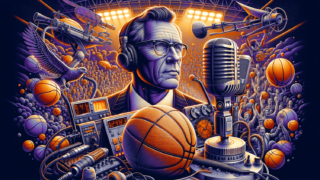
Rise of Player Empowerment in Basketball
Written by: Basketball Universe
Last updated:

In recent years, basketball has seen a remarkable transformation in the way players navigate their careers, shifting the balance of power and reshaping the dynamics of the sport. The rise of player empowerment in basketball has led to exciting new narratives, as athletes increasingly take control of their destinies both on and off the court. For those who hunger for a deep dive into this groundbreaking phenomenon, buckle up! In this blog post, we’ll not only explore the driving forces behind player empowerment, but also dissect the implications on team dynamics, contractual decisions, and the future of the game. So, whether you’re a die-hard fan or a casual observer, join us on this exhilarating journey and uncover how basketball’s finest are leaving an indelible mark on the sport by rewriting the rules of the game.
Rise of Player Empowerment in Basketball
The rise of player empowerment in basketball is a result of several factors, including the increasing influence of players on team decisions, the growth of individual player brands, social media presence, and the ability to influence personnel moves through contract negotiation. These changing dynamics have shifted the traditional balance of power, giving players more control over their careers, team compositions, and the direction of the sport itself. The impact of this trend is evident in various aspects of the game, including trades, free agency decisions, and the landscape of team-building strategies.
Impactful Moments in Basketball History: A Prelude to Player Empowerment
Looking back at basketball history, some key moments served as precursors to the emergence of player empowerment. From free agency to influential figures taking charge of their careers, the seeds of this revolution were sown decades ago, just waiting for the right conditions to take root.
The Oscar Robertson Rule
In 1976, the “Oscar Robertson Rule” ushered in the era of the free agency system in the NBA, after Robertson filed a landmark lawsuit resulting in a significant change in the league’s collective bargaining agreement. This opened the door for players to explore their options in the marketplace, paving the way for more freedom and control over their careers.
Driving Forces Behind the Rise of Player Empowerment
To understand the rise of player empowerment in basketball, we need to examine the driving forces that have contributed to this movement. These factors range from the expansion of players’ roles in team decisions to the impact of social media on athletes’ personal brands and influence.
Players as Decision Makers
One of the critical factors behind player empowerment is players assuming larger roles in team decisions, such as personnel moves and coaching hires. While conversations between team management and star players have always occurred, the extent and visibility of these discussions have grown. Players are now more involved in shaping their teams, influencing the front-office choices on whom to sign, draft, or trade for.
The Role of Super Teams
The formation of “super teams,” where multiple superstars join forces to chase championships, has also contributed to the rise of player empowerment. The Miami Heat’s 2010 acquisition of LeBron James and Chris Bosh to join forces with Dwyane Wade became a defining moment. It demonstrated that players could dictate their career trajectories in ways that were once unimaginable. Since that watershed event, we have seen superstars like Kevin Durant and Kawhi Leonard make strategic moves to create their own championship-contending squads.
Developing Player Brands
Players today are more than just athletes. They are fast-becoming influential brands, who use their platform to promote their interests and engage with fans. Through endorsements, personal merchandise lines, and signature shoes, players have managed to generate their own income and increase their market value. This multifaceted approach to their careers has contributed to the rise of player empowerment.
Social Media Influence
The age of social media has provided players with an unprecedented level of direct engagement with fans and critics alike. It has given athletes a voice to express opinions, share updates, and even challenge traditional media narratives. With this newfound influence, players have found yet another avenue to assert control over their careers and amplify their impact on the sport.
Real-Life Examples of Player Empowerment
Let’s delve into some real-life examples that demonstrate the different facets of player empowerment in basketball.
LeBron James: The King of Player Empowerment
A predominant example of player empowerment in action is LeBron James, who has consistently leveraged his influence and status to impact not only his own career but also that of his teammates and league dynamics. His decision to join the Miami Heat in 2010, return to Cleveland in 2014, and later sign with the Los Angeles Lakers in 2018, all exemplify how LeBron has controlled the narrative of his career.
LeBron has also played an active role in recruiting talented teammates, such as Anthony Davis, to join him in LA, creating another formidable super team. Off the court, his various business ventures in entertainment and production further contribute to the reach of his personal brand and influence.
Kawhi Leonard: The Power of the Silent Superstar
Kawhi Leonard, known for his quiet demeanor, still managed to make a powerful statement during his 2019 free agency. As he orchestrated meetings with different teams, Leonard’s choices determined the future of several franchises, as general managers around the league waited on his every move. Kawhi’s empowered decision to sign with the LA Clippers and bring Paul George alongside him reshaped the NBA landscape with a single stroke.
The Impact of Player Empowerment on Team Dynamics and Contract Negotiations
As player empowerment continues to rise, significant implications on team dynamics and contract negotiations become increasingly evident.
Reevaluating Team Chemistry
As players drive personnel decisions, there is an increased emphasis on the importance of team chemistry. The success of teams such as the Golden State Warriors and the Toronto Raptors demonstrates the value of camaraderie and unselfish play in winning championships. However, assembling talented players does not always guarantee success, as the importance of on-court fit, complementing skill sets, and shared goals come to the forefront.
Negotiating Contracts through Player Leverage
Players have used their influence to negotiate both more lucrative deals and more flexibility in their contracts. Shorter contracts with player options are now common, as athletes look to maximize their earning potential and maintain their ability to change teams as they please. LeBron James, Kevin Durant, and Kawhi Leonard have all negotiated shorter contracts with player options, influencing a new era of contract structure in the NBA.
Player Empowerment and the Role of Agents
Agents play a crucial role in advocating for their clients, and Rich Paul—founder of Klutch Sports Group—is the epitome of this influence. By representing players such as LeBron James, Anthony Davis, and Draymond Green, Paul has become a key figure in player empowerment negotiations, securing favorable contract terms and facilitating desired trades for his clients.
From the Locker Room to the Boardroom: Players Making Moves Off the Court
As player empowerment continues to expand, athletes have seized the opportunity to venture into other aspects of their lives, extending their footprint beyond the basketball court.
Philanthropic Efforts and Social Activism
Players like LeBron James and Chris Paul have used their influence and resources to spearhead philanthropic efforts and champion social causes. For instance, LeBron’s “I Promise” school in Akron, Ohio, demonstrates how significant player empowerment can have positive consequences for society.
Business Ventures
Off the court, many players are investing in diverse business opportunities, such as film and television production, technology, fashion and even team ownership. Kevin Durant and Steph Curry both started their own media production companies, while Michael Jordan and Magic Johnson have built business empires that extend well beyond their playing days.
The Shifting Dynamics of the NBA: Reshaping the Landscape
The rise of player empowerment has impacted the NBA landscape in various ways, spurring an array of reactions from the basketball world.
Fans and Media Perspectives
While some fans appreciate the increased level of control that players have over their careers, others bemoan the lack of loyalty to a single team. Likewise, the media has spotlighted the empowerment of players in both positive and negative ways, as they struggle to keep up with the rapid changes occurring within the league.
The NBA’s Response
The NBA has made several rule changes and adjustments to navigate the evolving dynamics of player empowerment. Changes in the collective bargaining agreement, trade restrictions, and tampering rules have been implemented to ensure a competitive balance and maintain league integrity.
Future of Player Empowerment in Basketball
The rise of player empowerment in basketball is not just a fleeting trend; it’s a movement that’s here to stay. As the NBA continues to adapt to the evolving landscape, we can expect even more seismic shifts as athletes leverage their ever-growing influence, power, and opportunities both on and off the court.
Implications of Player Empowerment on Smaller Market Teams
With the meteoric rise of player empowerment, it is crucial to consider its impact on small-market teams in the NBA. Historically, these teams have faced challenges in attracting and retaining top talents. As players gain more control over their careers, the scales have tipped unfavorably for these smaller market franchises.
Competitive Disadvantage
Players often prioritize joining star-studded rosters or teams in major media markets, leaving smaller market teams at a competitive disadvantage. The formation of super teams generally centers around larger markets or established contenders, exacerbating the challenges smaller franchises face in competing for championships.
Resource Allocation
Player empowerment can result in increased difficulty for smaller market teams when allocating limited resources to build a competitive squad. Attracting and retaining top talent often involves offering significantly inflated contracts or forming supporting rosters around a single player, which might not guarantee long-term success.
Addressing the Challenges: Strategy Adaptations by Smaller Market Teams
While the impact of player empowerment on small market teams has been profound, it has led these franchises to rethink and refocus their strategies to maintain competitiveness in the league.
Emphasis on Player Development
Talent search often emphasizes the discovery and nurturing of young, promising players who possess tremendous potential. By focusing on player development, small market teams can create a solid foundation for future success. The San Antonio Spurs, Milwaukee Bucks, and Oklahoma City Thunder are all excellent examples of franchises that heavily invested in developing talent, eventually reaping the rewards and fielding competitive squads.
Front Office Acumen
Player empowerment has forced small market teams to be more vigilant, creative, and discerning when it comes to front office decisions, including trades and contract negotiations. By assembling a strong supporting cast around homegrown talent, smaller market teams can increase their chances of retaining their stars and remaining relevant in the NBA landscape.
Creating a Winning Culture
Developing the right team culture and instilling winning values within the organization can also prove instrumental in attracting and retaining top talent, regardless of market size. A strong sense of camaraderie, trust, and leadership within the organization can lead to sustained success and help bridge the gap between these teams and their larger market counterparts.
An Evolving NBA Landscape: The Road Ahead
As the rise of player empowerment continues to evolve, challenges and opportunities will emerge for various stakeholders in the basketball world. Adaptation and creativity, both on and off the court, will be key for teams, players, and the NBA as a whole.
It is up to small market teams, the league, and its athletes to continually reassess their roles and relationships within this changing landscape, reinventing strategies to thrive in an era defined by empowered players and a rapidly shifting balance of power.
FAQ: Player Empowerment in Basketball
Having read about the rise of player empowerment in basketball, we understand that you may have some questions that need further clarity. In this FAQ section, we’ll address ten common questions and provide concise, informative answers to help deepen your understanding of this fascinating topic.
1. What is player empowerment?
Player empowerment refers to the growing influence and control that professional basketball players have over their careers, both on and off the court. This includes making decisions about their playing contracts, influencing team composition, and pursuing interests and ventures beyond basketball.
2. How did player empowerment begin?
Player empowerment began in the 1970s with the advent of free agency and has evolved over time through various factors, such as notable trade decisions, formation of super teams, increased player salaries, and the growth of individual player brands and social media presence.
3. How does player empowerment affect team dynamics?
Player empowerment impacts team dynamics through players playing a more significant role in personnel decisions, like trades or coaching hires. It also influences team chemistry as players control the formation of super teams and determine who they would like to play alongside, which affects on-court performance and the overall success of the franchise.
4. What are super teams and how do they relate to player empowerment?
Super teams are squads composed of multiple All-Star caliber players, typically assembled through strategic player movement or collaboration. These teams tend to be championship contenders and are closely tied to player empowerment, as stars often exercise their newfound influence over their careers to form such squads and increase their odds of winning titles.
5. How do agents play a role in player empowerment?
Agents act as advocates for their clients by negotiating favorable contract terms and facilitating desired trades. They often maintain strong relationships with team executives and help players navigate their careers, keeping their best interests in mind, and maximizing their opportunities both on and off the court.
6. How has social media contributed to player empowerment?
Social media has provided players with a direct line of communication with fans and critics. This increased visibility allows them not only to shape their public persona and personal brand, but also to challenge traditional media narratives, express their opinions, and wield greater influence within the sport.
7. Are there any negative consequences of player empowerment?
While player empowerment has several positive outcomes, there are potential negative consequences. Small market teams face increased challenges in attracting and retaining top talents, resulting in a competitive disadvantage. Also, a perceived lack of loyalty due to player movement can evoke mixed reactions from fans and media.
8. What effect does player empowerment have on contract negotiations?
Player empowerment has shifted the balance of power in contract negotiations, with players seeking shorter contracts and player options to maximize their earning potential and maintain flexibility. This trend is evident in several recent contracts for stars such as LeBron James and Kevin Durant.
9. How does player empowerment extend beyond the world of basketball?
Player empowerment extends beyond the court, as athletes use their stature and influence to engage in philanthropy, social activism, and business ventures. Building their personal brand and investing in diverse opportunities allow players to have a broader impact on society and their communities.
Player empowerment is likely to continue growing and evolving, shaping the NBA landscape in numerous ways. Both the league and its athletes must continually assess their roles and relationships in this changing environment and adapt to maintain a competitive balance, ensure league stability, and cater to varying interests.
Featured Posts
- No pillar pages found.





